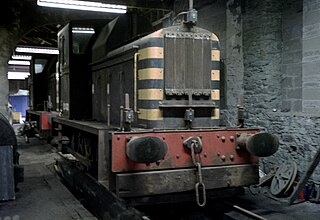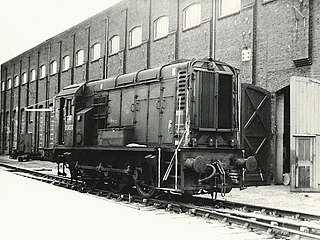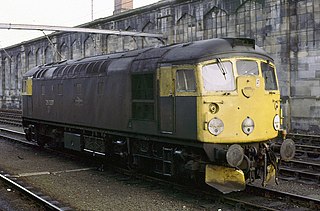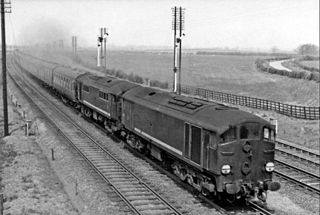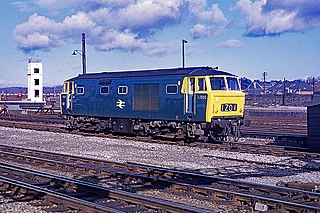| Loco | Final depot | Industrial career | Industrial Number [1] | Dates | Disposal |
|---|
| D9500 | 86A | NCB Ashington [12] | 1 | 11/69–? | Preserved at Peak Rail |
| D9501 | 86A | — | – | — | Scrapped at C F Booth, Rotherham (June 1968) [13] |
| D9502 | 86A | NCB Ashington [12] | – | 07/69–? | Preserved at East Lancs Railway |
| D9503 | 50B | BSC Harlaxton
BSC Corby Steelworks | 65 | 11/68–07/74
07/74–09/80 | Scrapped at BSC Corby (09/80) |
| D9504 | 50B | NCB Lambton [1]
NCB Philadelphia
NCB Bolden
NCB Burradon
NCB Ashington [12] | – | 11/68–08/73
08/73–12/74
01/75–09/81
09/81–? | Preserved at Kent & East Sussex Railway |
| D9505 | 50B | APCM Hope, Derbyshire [14] | – | 09/68–05/75 | Exported to Bruges, Belgium (05/75) |
| D9506 | 86A | — | – | — | Scrapped at Arnott Young Ltd., Parkgate (05/68) |
| D9507 | 50B | BSC Corby Steelworks [15] | 55 | 11/68–09/82 | Scrapped at BSC Corby (09/82) |
| D9508 | 87E | NCB Ashington [12] | 9 | 03/69–01/84 | Scrapped at D. Short, North Shields (01/84) |
| D9509 | 86A | — | – | — | Scrapped at G Cohen Ltd., Kettering (11/70) |
| D9510 | 50B | BSC Buckminster
BSC Corby Steelworks [15] | 60 | 12/68–06/72
06/72–08/82 | Scrapped at BSC Corby (08/82) |
| D9511 | 50B | NCB Ashington | – | 11/68–07/79 | Scrapped at NCB Ashington (07/79) |
| D9512 | 50B | BSC Buckminster
BSC Corby Steelworks [15] | 63 | 12/68–09/72
09/72–02/82 | Scrapped at BSC Corby (02/82) |
| D9513 | 86A | Arnott Young Ltd., Parkgate
NCB Crigglestone
NCB Astley
NCB Ashington [12] | 38 | 07/68–11/68
11/68–09/69
09/69–10/73
01/74–? | Preserved at Embsay & Bolton Abbey Steam Railway |
| D9514 | 86A | NCB Ashington [12] | 4 | 07/69–12/85 | Scrapped at NCB Ashington (12/85) |
| D9515 | 50B | BSC Buckminster
BSC Corby Steelworks
Hunslet Ltd | 62 | 11/68–09/72
09/72–12/81
12/81–07/82 | Exported to Charmartin, Madrid, Spain (07/82) |
| D9516 | 50B | BSC Corby Steelworks | 56 | 11/68–10/81 | Preserved at Didcot Railway Centre |
| D9517 | 86A | NCB Ashington [12] | 8 | 11/69–01/84 | Scrapped at D. Short, North Shields (01/84) |
| D9518 | 86A | NCB Ashington [12] | 7 | 06/69–??/87 | Preserved at West Somerset Railway |
| D9519 | 86A | – | – | – | Scrapped at G Cohen Ltd., Kettering (11/70) |
| D9520 | 50B | BSC Corby Steelworks BSC Glendon [1] | 45 | 12/68–03/81 | Preserved at Mid-Norfolk Railway |
| D9521 | 87E | NCB Ashington [12] | 3 | 03/70–11/84 | Preserved at Dean Forest Railway |
| D9522 | 86A | – | – | – | Scrapped at Arnott Young Ltd., Parkgate (05/68) |
| D9523 | 50B | BSC Corby Steelworks BSC Glendon [1] | 46 | 12/68–10/81 | Preserved at the Wensleydale Railway |
| D9524 | 87E | BP Grangemouth | – | 07/70–09/81 | Preserved at Peak Rail |
| D9525 | 50B | NCB Lambton [1] NCB Philadelphia
NCB Ashington [12] | – | 11/68–03/75
03/75–10/87 | Preserved by Heritage Shunters Trust |
| D9526 | 86A | APCM Westbury | – | 01/70–04/80 | Preserved at West Somerset Railway |
| D9527 | 86A | NCB Ashington [12] | 6 | 07/69–01/84 | Scrapped at D. Short, North Shields (01/84) |
| D9528 | 86A | NCB Ashington [12] | 2 | 03/69–12/81 | Scrapped at D. Short, North Shields (12/81) |
| D9529 | 50B | BSC Buckminster
BSC Corby Steelworks
Bardon Hill Quarry | 61 | 08/68–09/72
09/72–03/81
02/09–06/10 | Preserved – normally at Nene Valley Railway |
| D9530 | 86A | Gulf Oil Co.Ltd., Waterston
NCB Mardy Colliery [12]
NCB Tower Colliery | – | 09/69–10/75
10/75–08/82
08/82 | Scrapped at NCB Tower Colliery (08/82) |
| D9531 | 86A | Arnott Young Ltd., Parkgate
NCB Crigglestone
NCB Burradon
NCB Ashington [12] | – | 07/68–11/68
11/68–10/73
10/73–04/74
04/74–? | Preserved at East Lancashire Railway |
| D9532 | 50B | BSC Corby Steelworks [15] | 57 | 11/68–02/82 | Scrapped at BSC Corby (02/82) |
| D9533 | 50B | BSC Corby Steelworks [15] | 47 | 12/68–09/82 | Scrapped at BSC Corby (09/82) |
| D9534 | 50B | APCM Hope, Derbyshire [14] | – | 10/68—05/75 | Exported to Bruges, Belgium (05/75) |
| D9535 | 86A | NCB Burradon
NCB Backworth
NCB Ashington [12] | 37 | 11/70–01/76
01/76–09/80
09/80–01/84 | Scrapped at NCB Ashington (01/84) |
| D9536 | 87E | NCB Ashington [12] | 5 | 03/70–02/85 | Scrapped at NCB Ashington (12/85) |
| D9537 | 50B | BSC Corby Steelworks | 52 | 11/68–11/82 | Preserved at Ecclesbourne Valley Railway |
| D9538 | 87E | Shell-Mex & BP Ltd., Shellhaven
BSC Ebbw Vale
BSC Corby Steelworks [15] | – | 04/70–02/71
02/71–04/76
04/76–09/82 | Scrapped at BSC Corby (09/82) |
| D9539 | 50B | BSC Corby Steelworks [15] | 51 | 10/68–02/83 | Preserved at Ribble Steam Railway |
| D9540 | 50B | NCB Lambton [1] NCB Philadelphia
NCB Burradon
NCB Ashington [12] | 36 | 11/68–11/71
11/71–06/72
06/72–01/84 | Scrapped at D. Short, North Shields (01/84) |
| D9541 | 50B | BSC Harlaxton
BSC Corby Steelworks [15] | 66 | 11/68–08/74
08/74–08/82 | Scrapped at BSC Corby (08/82) |
| D9542 | 50B | BSC Corby Steelworks [15] | 48 | 12/68–08/82 | Scrapped at BSC Corby (08/82) |
| D9543 | 50B | — | – | — | Scrapped at C F Booth, Rotherham (11/68) |
| D9544 | 50B | BSC Corby Steelworks | 53 | 11/68–09/80 | Scrapped at BSC Corby (09/80) |
| D9545 | 50B | NCB Ashington | – | 11/68–07/79 | Scrapped by D. Short, North Shields (07/79) |
| D9546 | 50B | — | – | — | Scrapped at C F Booth, Rotherham (11/68) |
| D9547 | 50B | BSC Corby Steelworks [15] | 49 | 12/68–08/82 | Scrapped at BSC Corby (08/82) |
| D9548 | 50B | BSC Harlaxton
BSC Corby Steelworks
Hunslet Ltd | 67 | 11/68–08/74
08/74–11/80
11/80–07/82 | Exported to Charmartin, Madrid, Spain (07/82) |
| D9549 | 50B | BSC Corby Steelworks
Hunslet Ltd | 64 | 11/68–11/81
11/81–07/82 | Exported to Charmartin, Madrid, Spain (07/82) |
| D9550 | 50B | — | – | — | Scrapped at C F Booth, Rotherham (11/68) |
| D9551 | 50B | BSC Corby Steelworks | 50 | 12/68–06/81 | Preserved at Severn Valley Railway |
| D9552 | 50B | BSC Buckminster
BSC Corby Steelworks | 59 | 09/68–06/72
06/72–09/80 | Scrapped at BSC Corby (09/80) |
| D9553 | 50B | BSC Corby Steelworks [15] | 54 | 11/68–? | Preserved at Vale of Berkeley Railway |
| D9554 | 50B | BSC Corby Steelworks [15] | 58 | 11/68–08/82 | Scrapped at BSC Corby (08/82) |
| D9555 | 87E | NCB Burradon
NCB Ashington [12] | – | 03/70–02/75
02/76–??/87 | Preserved at Dean Forest Railway |




